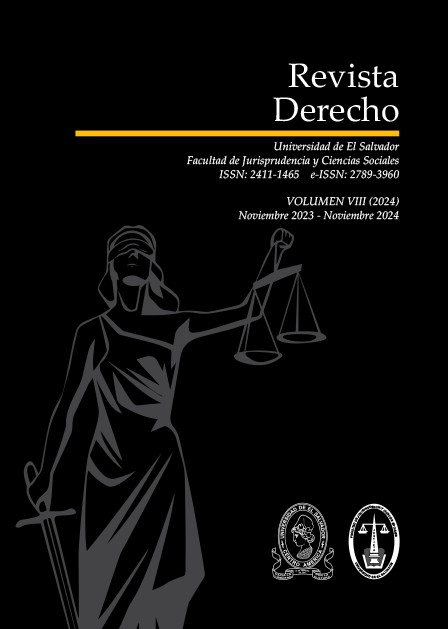The opposition between power and violence in the restructuring of the historical center of San Salvador from the theoretical perspective of Hannah Arendt
Keywords:
power, violence, authority, legitimacy, historical center of San Salvador, occupation of public spaces, Hannah ArendtAbstract
The article addresses the relation between power and violence in the context of the history and politics of El Salvador, specifically in the conflict over the restructuring of the historic center of San Salvador, where informal vendors occupied public spaces for decades. Hannah Arendt's vision of violence as a means to achieve immediate ends, but neither legitimate nor lasting over time, stands out. Since colonial times, violence has been used (instrumentalized) by those who control political power to subjugate others. In El Salvador, political and social conflicts have been recurrent, with marginal groups resorting to violence when they are excluded from decision-making and opportunities. The State has also exercised so-called legitimate violence as a tool of control. But Arendt argues that power and violence are opposites: while power arises from the agreement between people, violence is instrumental and can destroy power. In the case of the historic center of San Salvador, municipal governments attempted to evict informal vendors by force, but these actions did not achieve lasting solutions and generated more conflict. Only through dialogue and negotiation between vendors and the municipal government was a peaceful and voluntary evacuation of public spaces achieved, returning power and control to the local government. This illustrates Arendt's idea: power is based on consensus and is lost when violence is resorted to indiscriminately.
Downloads
References
Arendt, Hannah. Sobre la violencia. Madrid: Alianza, 2008.
Arendt, Hannah, Ramón Gil Novales, y Hannah Arendt. La condición humana. 1. Aufl., 7. Nachdr. Buenos Aires: Paidós, 2011.
Botello, Nelson Arteaga. «El espacio de la violencia: un modelo de interpretación social». Sociológica 18, n.o 52 (2003): 119-45.
Campos Solórzano, Melissa Regina. «Grupos vulnerables y uso del espacio público en el centro histórico de San Salvador. Caso calle Arce», 30 de diciembre de 2019. http://biblioteca.utec.edu.sv:8080/jspui/handle/11298/1123.
Cruz, José Miguel. «Los factores posibilitadores y las expresiones de la violencia en los noventa». ECA: Estudios Centroamericanos 52, n.o 588 (31 de octubre de 1997): 977-92. https://doi.org/10.51378/eca.v52i588.6460.
Di Pego, Anabella. «Poder, violencia y revolución en los escritos de Hannah Arendt : Algunas notas para repensar la política». Argumentos (México) 19, n.o 52 (2006): 101-22.
Fundación Salvadoreña de Desarrollo y Vivienda Mínima, FUNDASAL. «Centro Histórico de San Salvador y la presencia de organizaciones sociales.» Carta Urbana No. 128, septiembre de 2005, 16.
La Prensa Gráfica. «Los inamovibles», 3 de marzo de 2013. https://www.laprensagrafica.com/revistas/Los-inamovibles-20130303-0094.html.
Manzo, Enrique Guerra. «Civilización y violencia en la obra de Norbert Elias». Iztapalapa Revista de Ciencias Sociales y Humanidades 30, n.o 74/1 (2013): 129-54.
Nuila, Carlos. «Patrimonio cultural de El Salvador (listado 2022)». Revista Culturel (blog), 3 de agosto de 2022. https://revistaculturel.com/articulos/patrimonio-cultural-de-el-salvador/.
Paley, Dawn. Drug War Capitalism. Edinburgh Oakland Baltimore: AK Press, 2014.
Rojas, Eduardo. Volver al centro: La recuperación de las áreas urbanas centrales. New York: Banco Interamericano de Desarrollo, 2004.
Salazar Araya, Sergio. Democratización y seguridad en El Salvador: las políticas de combate a las maras durante el gobierno de Francisco Flores (2004-2009). Primera edición. Ciudad Universitaria Rodrigo Facio, San José, Costa Rica: Editorial UCR, 2020.
Vidal Vidales, Ana Cristina, y Julio César Martínez Rivera. «Recuperación de espacios públicos. El caso del microcentro del centro histórico de San Salvador». Revista Entorno, n.o 53 (agosto de 2013): 15-20.
Downloads
Published
Issue
Section
License
Copyright (c) 2024 Revista Derecho

This work is licensed under a Creative Commons Attribution-NonCommercial 4.0 International License.
The authors transfer the copyright rights in favor of the Faculty of Jurisprudence and Social Sciences of the University of El Salvador (through Aequus Editorial) to include their writing in Revista Derecho.








